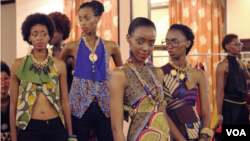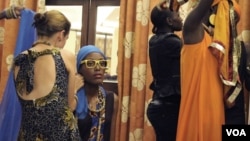KAMPALA —
When it comes to locally-made clothes, East Africa lags behind other regions, hamstrung by the ubiquity of cheap foreign-made castoffs. But now the producers of New York Fashion Week are helping to kick-start East Africa’s fashion industry.
They say a series of runway shows could create thousands of jobs, especially for women.
Like hundreds of entrepreneurs in the Ugandan capital, Kampala, Emily Walusimbi is in the business of fashion. She sells clothes from a small shop on the side of the road, where women of all ages come to look stylish.
“They want to go with the trend - what they see in magazines, what they see on the net, that’s what they want, not what their parents wear,” she explained.
But all Walusimbi’s clothes are second-hand, made in Europe, and the trends her customers want to follow come from Europe as well.
“If there is a new style in Europe they get on the net, so they say ‘I want that one,’” she said.
Unlike in West or Southern Africa, East African women get almost all their fashion from Europe and America, said Ugandan fashion designer Gloria Wavamunno. Even local tailors shy away from creating their own designs. “We tailor Western styles. So we copycat rather than innovate,” she stated.
But this year a group of producers and designers is hoping to kick-start a home-grown fashion industry they say would benefit the regional economy.
Backstage at a recent Kampala fashion show, dozens of models and stylists put the final touches on flowing robes, chunky metallic jewelry and African-patterned tunics.
LDJ Productions, the producers of New York Fashion Week, are helping to stage a series of runway events throughout the region to showcase local designers and attract sponsorship. They are also planning workshops in business development, marketing and social media.
CEO Laurie DeJong said the fashion industry can help with development by boosting commerce and creating jobs, especially for women.
“In New York we do Fashion Week in Lincoln Center twice a year, and just in the neighborhood that we do fashion week in, it brings in $82 million in revenue. So the potential here is enormous," DeJong explained. "And for women there’s not a huge amount of opportunity in the region, but fashion is just a great vehicle for women.”
But East Africa has a long way to go, she said.
“Because it’s nowhere near where it is in South Africa or Nigeria right now. They’re probably about four to five steps behind. And I think it’s just because it’s such a new industry. The resources aren’t here yet, and part of what we’re helping to do is to assist in bringing in the right resources,” she said.
Attitudes are slowly starting to change, said Wavamunno, as East Africans come to see fashion as art.
“I feel locally, we are just starting to understand or appreciate our own local artists and understand that yes, they can be what you’re wearing. You don’t have to feel clothes are only made internationally,” she said.
But with so many second-hand Western clothes available in markets and shops, some costing less than a dollar, building a business is an uphill battle. The solution, may need to come from politicians.
“Second-hand sounds reasonable because it’s quick and it’s cheap. But we need to now create a balance of it, and that also starts politically, because we also need to then have our government controlling the amount of second-hand that comes [into] our country,” Wavamunno added.
DeJong and her team are partnering with a regional arts association on a series of fashion weeks later this year in Uganda, Rwanda and Burundi.
They say a series of runway shows could create thousands of jobs, especially for women.
Like hundreds of entrepreneurs in the Ugandan capital, Kampala, Emily Walusimbi is in the business of fashion. She sells clothes from a small shop on the side of the road, where women of all ages come to look stylish.
“They want to go with the trend - what they see in magazines, what they see on the net, that’s what they want, not what their parents wear,” she explained.
But all Walusimbi’s clothes are second-hand, made in Europe, and the trends her customers want to follow come from Europe as well.
“If there is a new style in Europe they get on the net, so they say ‘I want that one,’” she said.
Unlike in West or Southern Africa, East African women get almost all their fashion from Europe and America, said Ugandan fashion designer Gloria Wavamunno. Even local tailors shy away from creating their own designs. “We tailor Western styles. So we copycat rather than innovate,” she stated.
But this year a group of producers and designers is hoping to kick-start a home-grown fashion industry they say would benefit the regional economy.
Backstage at a recent Kampala fashion show, dozens of models and stylists put the final touches on flowing robes, chunky metallic jewelry and African-patterned tunics.
LDJ Productions, the producers of New York Fashion Week, are helping to stage a series of runway events throughout the region to showcase local designers and attract sponsorship. They are also planning workshops in business development, marketing and social media.
CEO Laurie DeJong said the fashion industry can help with development by boosting commerce and creating jobs, especially for women.
“In New York we do Fashion Week in Lincoln Center twice a year, and just in the neighborhood that we do fashion week in, it brings in $82 million in revenue. So the potential here is enormous," DeJong explained. "And for women there’s not a huge amount of opportunity in the region, but fashion is just a great vehicle for women.”
But East Africa has a long way to go, she said.
“Because it’s nowhere near where it is in South Africa or Nigeria right now. They’re probably about four to five steps behind. And I think it’s just because it’s such a new industry. The resources aren’t here yet, and part of what we’re helping to do is to assist in bringing in the right resources,” she said.
Attitudes are slowly starting to change, said Wavamunno, as East Africans come to see fashion as art.
“I feel locally, we are just starting to understand or appreciate our own local artists and understand that yes, they can be what you’re wearing. You don’t have to feel clothes are only made internationally,” she said.
But with so many second-hand Western clothes available in markets and shops, some costing less than a dollar, building a business is an uphill battle. The solution, may need to come from politicians.
“Second-hand sounds reasonable because it’s quick and it’s cheap. But we need to now create a balance of it, and that also starts politically, because we also need to then have our government controlling the amount of second-hand that comes [into] our country,” Wavamunno added.
DeJong and her team are partnering with a regional arts association on a series of fashion weeks later this year in Uganda, Rwanda and Burundi.







